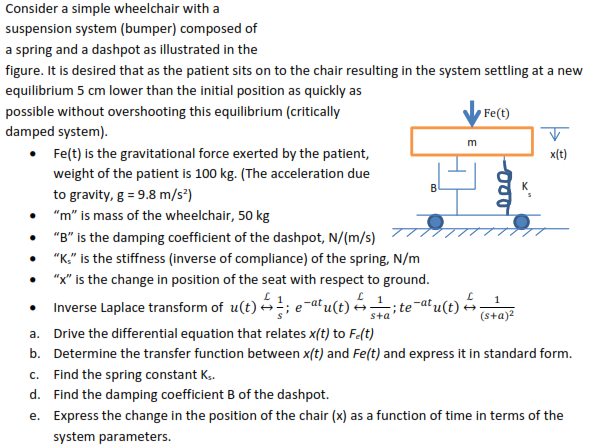Consider a simple wheelchair with a suspension system (bumper) composed of a spring and a dashpot as illustrated in the figure. It is desired that as the patient sits on to the chair resulting in the system settling at a new equilibrium 5 cm lower than the initial position as quickly as possible without overshooting this equilibrium (critically damped system). Fe(t) is the gravitational force exerted by the patient, weight of the patient is 100 kg. (The acceleration due to gravity, g = 9.8 m/s²) "m" is mass of the wheelchair, 50 kg "B" is the damping coefficient of the dashpot, N/(m/s) "K," is the stiffness (inverse of compliance) of the spring, N/m "x" is the change in position of the seat with respect to ground. Inverse Laplace transform of u(t); m -ite-atu(t) +₂ s+a Fe(t) -000 e-atu(t) • a. Drive the differential equation that relates x(t) to F.(t) b. Determine the transfer function between x(t) and Fe(t) and express it in standard form. c. Find the spring constant K₁. d. Find the damping coefficient B of the dashpot. e. Express the change in the position of the chair (x) as a function of time in terms of the x(t) (s+a)²
Consider a simple wheelchair with a suspension system (bumper) composed of a spring and a dashpot as illustrated in the figure. It is desired that as the patient sits on to the chair resulting in the system settling at a new equilibrium 5 cm lower than the initial position as quickly as possible without overshooting this equilibrium (critically damped system). Fe(t) is the gravitational force exerted by the patient, weight of the patient is 100 kg. (The acceleration due to gravity, g = 9.8 m/s²) "m" is mass of the wheelchair, 50 kg "B" is the damping coefficient of the dashpot, N/(m/s) "K," is the stiffness (inverse of compliance) of the spring, N/m "x" is the change in position of the seat with respect to ground. Inverse Laplace transform of u(t); m -ite-atu(t) +₂ s+a Fe(t) -000 e-atu(t) • a. Drive the differential equation that relates x(t) to F.(t) b. Determine the transfer function between x(t) and Fe(t) and express it in standard form. c. Find the spring constant K₁. d. Find the damping coefficient B of the dashpot. e. Express the change in the position of the chair (x) as a function of time in terms of the x(t) (s+a)²
Classical Dynamics of Particles and Systems
5th Edition
ISBN:9780534408961
Author:Stephen T. Thornton, Jerry B. Marion
Publisher:Stephen T. Thornton, Jerry B. Marion
Chapter11: Dynamics Of Rigid Bodies
Section: Chapter Questions
Problem 11.15P
Related questions
Question

Transcribed Image Text:Consider a simple wheelchair with a
suspension system (bumper) composed of
a spring and a dashpot as illustrated in the
figure. It is desired that as the patient sits on to the chair resulting in the system settling at a new
equilibrium 5 cm lower than the initial position as quickly as
possible without overshooting this equilibrium (critically
Fe(t)
damped system).
• Fe(t) is the gravitational force exerted by the patient,
weight of the patient is 100 kg. (The acceleration due
m
x(t)
B
to gravity, g = 9.8 m/s³)
• "m" is mass of the wheelchair, 50 kg
"B" is the damping coefficient of the dashpot, N/(m/s)
"K." is the stiffness (inverse of compliance) of the spring, N/m
"x" is the change in position of the seat with respect to ground.
Inverse Laplace transform of u(t) ;
1
ite-at
sta
(s+a)?
a. Drive the differential equation that relates x(t) to F-(t)
b. Determine the transfer function between x(t) and Fe(t) and express it in standard form.
c. Find the spring constant K.
d. Find the damping coefficient B of the dashpot.
e. Express the change in the position of the chair (x) as a function of time in terms of the
system parameters.
Expert Solution
This question has been solved!
Explore an expertly crafted, step-by-step solution for a thorough understanding of key concepts.
Step by step
Solved in 2 steps with 2 images

Knowledge Booster
Learn more about
Need a deep-dive on the concept behind this application? Look no further. Learn more about this topic, physics and related others by exploring similar questions and additional content below.Recommended textbooks for you

Classical Dynamics of Particles and Systems
Physics
ISBN:
9780534408961
Author:
Stephen T. Thornton, Jerry B. Marion
Publisher:
Cengage Learning

Principles of Physics: A Calculus-Based Text
Physics
ISBN:
9781133104261
Author:
Raymond A. Serway, John W. Jewett
Publisher:
Cengage Learning

University Physics Volume 1
Physics
ISBN:
9781938168277
Author:
William Moebs, Samuel J. Ling, Jeff Sanny
Publisher:
OpenStax - Rice University

Classical Dynamics of Particles and Systems
Physics
ISBN:
9780534408961
Author:
Stephen T. Thornton, Jerry B. Marion
Publisher:
Cengage Learning

Principles of Physics: A Calculus-Based Text
Physics
ISBN:
9781133104261
Author:
Raymond A. Serway, John W. Jewett
Publisher:
Cengage Learning

University Physics Volume 1
Physics
ISBN:
9781938168277
Author:
William Moebs, Samuel J. Ling, Jeff Sanny
Publisher:
OpenStax - Rice University